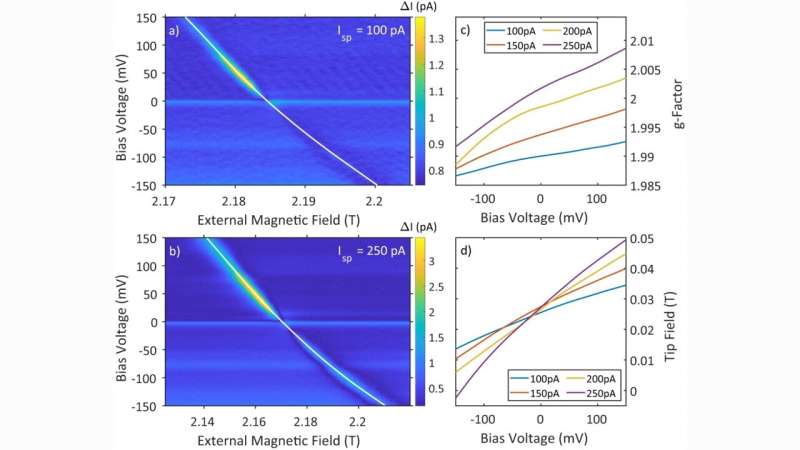October 27, 2023 feature
This article has been reviewed according to Science X's editorial process and policies. Editors have highlighted the following attributes while ensuring the content's credibility:
fact-checked
peer-reviewed publication
trusted source
proofread
Scientists demonstrate electric control of atomic spin transitions

A new study published in Nature Communications delves into the manipulation of atomic-scale spin transitions using an external voltage, shedding light on the practical implementation of spin control at the nanoscale for quantum computing applications.
Spin transitions at the atomic scale involve changes in the orientation of an atom's intrinsic angular momentum or spin. In the atomic context, spin transitions are typically associated with electron behavior.
In this study, the researchers focused on using electric fields to control the spin transitions. The foundation of their research was serendipitous and driven by curiosity.
Dr. Christian Ast, the lead author from the Max-Planck-Institute for Solid State Research, explained to Phys.org, "Our inspiration arose from sheer curiosity. We developed our machine and experimental method just before starting this project."
"As we were characterizing our new experiment, we observed something strange. We found that our signal changes depending on the bias voltage that we apply in our junction. The project and the following research grew from this observation."
Electron spins and spin transitions
Electrons possess intrinsic spin, which can be either "up" or "down." These spin states are often represented by quantum numbers, such as +1/2 for "up" and -1/2 for "down." When electrons transition between these spin states, it can result in various observable effects.
The manipulation of these spins is fundamental for quantum computing, where electron spins are used as qubits, and for spintronics, which enhances data processing and storage. It also impacts materials science and fundamental physics, providing both technological and scientific advancements.
In this study, the experimental setup was crucial to manipulate the spins. At the core of the apparatus was an electron spin resonance scanning tunneling microscope (ESR-STM). ESR-STM is a hybrid system that seamlessly integrates two powerful techniques: ESR and STM. With this innovative setup, individual atoms and molecules were precisely deposited onto the sample surface, offering a unique window into the atomic world.
Dr. Ast explained, "ESR-STM combines the capabilities of ESR and STM, enabling us to both resolve individual atoms and molecules in a topographic scan and probe them with an electric current."
Bias voltage and induced electric field
For the sample, the researchers chose to study single titanium hydride (TiH) molecules. The crux of the experiment relied on the strategic application of a bias voltage between the sample and the tip of the STM.
The application of this bias voltage induced a potent electric field within the tunnel junction, a narrow gap formed between the tip and the sample, where electrons can tunnel through.
The researchers noticed that the induced electric field affected the position of the TiH molecule, subsequently modifying the g-factor. The g-factor, or Landé g-factor, represents the proportionality between an electron's intrinsic angular momentum, or spin, and its magnetic moment, providing insights into its behavior in a magnetic field.
Further, they noticed that the induced electric field resulted in the TiH molecule interacting with a unique magnetic field, induced by the polarized spin of the STM tip
In essence, the bias voltage emerged as a potent tool for manipulating spin transitions.
Zeeman effect and future work
With this knowledge as a foundation, the researchers ventured further to explore the Zeeman effect. The Zeeman effect is the phenomenon where the energy levels of electron spin states in individual molecules split in the presence of a magnetic field.
"By applying a magnetic field to our STM junction, we can split the energy levels of two spin states in the individual molecules (Zeeman effect). From here, we are able to pick up changes in our electric current if we apply radio frequencies (for ESR) that correspond to the resonant energy of our spin states. Hence, the name electron spin resonance," explained Dr. Ast.
They also demonstrated direct electric control of spin transitions in coupled TiH dimers, which are pairs of TiH molecules bound together. This achievement was made possible through spin-electron coupling, a phenomenon where electrons' spins interact with one another. This revealed the potential for harnessing the cooperative behavior of spin states in these dimers.
Looking ahead to future research, Dr. Ast explained that his team already had several ideas. "In our research, we've discovered that changes in spin resonances concerning the electric field are attributed to two factors: variations in the local magnetic field and alterations in the molecule's spin."
"The exact reasons for these changes when modifying the electric field remain partially unexplained, warranting further investigation. This effect also holds promise for utilizing spin transitions as sensors to detect local electric fields within complex molecules," he concluded.
This research could open the door for individual atoms to serve as spin qubits in quantum computers, offering a faster alternative to traditional mechanical manipulations. The ability to control spin locally and swiftly through electrical means holds promise for quantum computing applications, where speed is critical to prevent information loss due to decoherence.
More information: Piotr Kot et al, Electric control of spin transitions at the atomic scale, Nature Communications (2023). DOI: 10.1038/s41467-023-42287-2
Journal information: Nature Communications
© 2023 Science X Network




















